Civil War Era Surgical and Medicine Textbooks
Authors:
Golding Bird,
William Senshouse Kirkes, Richard Barwell, Thomas Watson, Robert D. Lyons,
Alfred S. Taylor, Edward Hartshorne, Edwin Maxon
Page Eight
The following medical and surgical
texts were used immediately before or during the Civil War. They are a
window into a medical education as it was presented to the students and
surgeons who served in the War. There were a multitude of
medical
colleges in the late 1850's and 60's, as well as publishers who sold text
books from American, English and French authors.
Urinary Deposits, their
Diagnosis, Pathology and Therapeutical Indications, (1845), by Golding Bird,
M.D.
Bird (1814-54), a British physician,
"described oxaluria (1842), wrote an important book on 'Urinary
Deposits' (1844), and was a pioneer in static
electro-therapy (1841-49)"[Garrison,p.629].
Additional information
on Golding Bird, M.D.
|

Publisher Lea's 1846
display ad about this author
First American edition
227pp.,32pp. pub. catg. 33 text illus. of microscopic views |
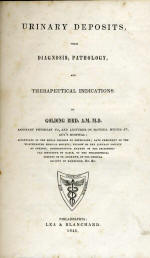

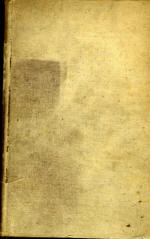
|
Manual of
Physiology, (1859), by William Senhouse Kirkes, M.D.
A copy of this text book is
listed in the 1865 Surgeon
General's Office Library Catalogues
KIRKES, WILLIAM
SENHOUSE MD, Demonstrator of Morbid Anatomy at St. Bartholomew's
Hospital. A MANUAL OF PHYSIOLOGY. A new American edition from
the third and improved London edition. With two hundred
illustrations In one large and handsome royal 12mo volume leather,
pp 586 $2.00.
This is a new and very much improved edition of
Dr Kirkes well known Handbook of Physiology. It combines
conciseness with completeness and is therefore admirably adapted for
consultation by the busy practitioner. Dublin Quarterly Journal. Its
excellence is in its compactness its clearness and its carefully
cited authorities it is the most convenient of text books. These
gentlemen Messrs Kirkes and Paget have the gift of telling us what
we want to know without thinking it necessary to tell us all they
know. Boston Med and Surg Journal. For the student beginning
this study and the practitioner who has the leisure to refresh his
memory this book is invaluable as it contains all that it is
important to know. Charleston Med Journal, 1861
There are
illustrations of the development of the embryo and many other
illustrations of anatomical references. There is a great index in
the back that list every subject. Medical, Anatomy Physiology
|

Publisher Blanchard & Lea's 1861
display ad about this author |


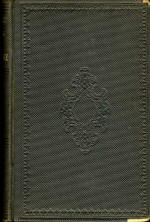 |
A Treatise on
Diseases of the Joint, (1861), by Richard Barwell, M.D.
Book is bound in paper
covers for use at the publisher's office.
The first of three books Barwell wrote
on orthopedics, the other two being: On the Cure of Club-Foot without
Cutting Tendons, and on Certain New Methods of Treating Other Deformities
(1863); and The Causes and Treatment of Lateral Curvature of the Spine
(1868). Barwell's "conservatism . . . showed in his Treatise on Diseases of
the Joints . . ., in which he stressed the function of the epiphyseal plates
and the risks of retardation of growth from knee-joint resection in youth"
(Le Vay, History of Orthopaedics, p. 129). Peltier, Orthopedics, a History
and Iconography, p. 243. Barwell's "chief attention was devoted to
orthopaedic surgery. . . . For the treatment of club-foot he advocated
instrumental methods, and opposed excessive adoption of tenotomy by the
so-called subcutaneous surgery then prevailing.
|
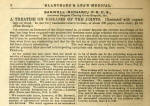
Publisher Blanchard & Lea's 1861
display ad about this author.
1861. Softcover. 1st
Edition. 8vo. vii, 463 pp. |
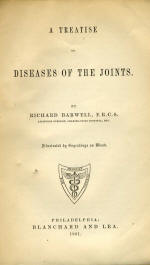

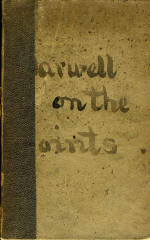
|
Lectures on the
Principles and Practice of Physic, (1858), by Thomas Watson, M.D.
A copy of this text book is
listed in the
1864 Surgeon
General's Office Library Catalogue
First published in the
Medical Times & Gazette, 1840-42, Watson’s famous lectures appeared in book
form and formed the most important treatise of medicine for a quarter
century. Watson wrote in a fine style, and his book was reorganized as a
sound guide to clinical medicine. Watson suggested rubber gloves for
antisepsis; he also instructed his students to wash their hands in a
solution of chloride of lime before assisting at deliveries." Garrison and
Morton. Thomas Watson studied at Cambridge and later became chair of the
principles and practice of medicine at King’s College. Watson served as
president of the Royal College of Physicians for five years and also was
Gulstonian and Lumleian lecturer.
A Treatise
on Fever, (1861), by Robert D. Lyons, K. C. C., Professor of Practice of
Medicine
A copy of this text book is
listed in the
1864 Surgeon
General's Office Library Catalogue
Additional
information on Robert Lyons
This textbook takes on significant importance in
consideration of the effect Yellow Fever had on the deployment of troops
during the Civil War. During the summer months, the troops were
not deployed to the hot and humid areas which were prone to mosquito
infestations and the resultant spread of Yellow Fever or other insect borne
diseases.
LYONS ROBERT D, K.C.C., Late Pathologist in chief to the
British Army in the Crimea. A TREATISE ON FEVER or selections from a
course of Lectures on fever being part of a course of Theory and Practice of
Medicine. In one neat octavo volume of 362 pages extra cloth $2.00.
We have great pleasure in recommending Dr Lyons work on fever to the
attention of the profession. It is a work which cannot fail to enhance
the author's previous well earned reputation as a diligent careful and
accurate observer. British Medical Journal, March 2 1861. Taken
as a whole we can recommend it in the highest terms as well worthy the
careful perusal and study of every student and practitioner of medicine.
We consider the work a most valuable addition to medical literature and one
destined to wield no little influence over the mind of the profession.
Med and Surg Reporter May 4 1861. This is an admirable work upon the
most remarkable and most important class of diseases to which mankind are
liable. Med. Journal of N. Carolina, May 1861

Publisher Blanchard & Lea's 1861
display ad about this author
Philadelphia Blanchard and
Lea 1861; Covers general fever, synochal, typhous, typhoid,
typhoid fever of Crimea, yellow fever, more. ; Large 8vo 9" ;
362 pages. First Edition. |
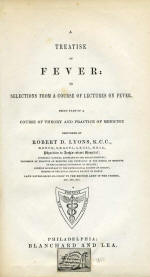

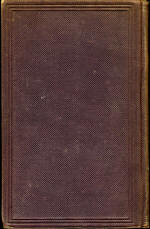 |
Poisons in
Relation to Medical Jurisprudence and Medicine, (1859), by Alfred S.
Taylor, M. D.
A copy of this text book is
listed in the
1864 Surgeon
General's Office Library Catalogues
"In laying the
present work before the profession, the desire of the author has been to
give a more extended view of the subject of TOXICOLOGY than he has
hitherto been able to introduce into his MANUAL OF MEDICAL
JURISPRUDENCE" (Preface, p. v). "Taylor's interest in forensic medicine
led to his appointment to the first chair of medical jurisprudence at
Guy's in 1831. . . . It was the first chair in that subject in London
and Taylor held the post until he retired in 1878. . . . His two major
works, Elements of Medical Jurisprudence (London, 1836) and Poisons in
Relation to Medical Jurisprudence and Medicine (London, 1848), became
standard works during his lifetime because they systematized legal
principles and court rulings so skillfully with toxicological data and
anatomical and pathological findings" (annotation to Heirs of
Hippocrates 1693). See Garrison-Morton 1738 for Taylor's 1836 Elements
of Medical Jurisprudence, which evolved into his Manual. See Nemec,
Highlights in Medicolegal Relations no. 389. See Garrison
Morton-1738
|

Publisher Blanchard and Lea's 1859
display ad about this author |
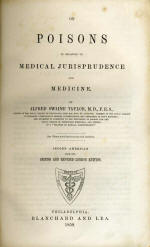

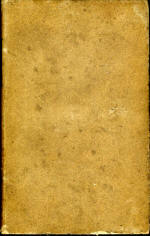 |
Medical Jurisprudence, (1861), by Alfred S. Taylor, M.D., F.R.S., edited
by Edward Hartshorne, M.D.
A copy of this text book is
listed in the
1865
Surgeon
General's Office Library Catalogues
See
additional information on Edward Hartshorne, M.D.
During the civil war
Hartshorne was on duty as Acting Assistant Surgeon, in the
field, after the battle of Antietam, and for one or two years, as
attending or consulting surgeon, to the McClellan, Nicetown and other
Army Hospitals in or near Philadelphia. He was actively engaged in the
organization of the Philadelphia branch of the United States Sanitary
Commission, during the war, being Secretary of its Executive Committee.
He was Secretary of the First National Quarantine and Sanitary
Convention, which met in Philadelphia a few years before the war.
"It is a
cornerstone of English medical jurisprudence of the 19th century . .
. [and] brought Taylor recognition throughout the world as a leader
in legal medicine and toxicology" [Nemec Highlights in Medicolegal
Relations #389]
|

From the publisher, Blanchard and Lea 1861 display ad about this author |
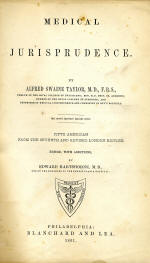 
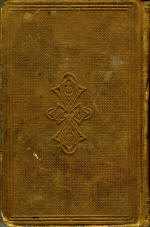 |
Medical Jurisprudence, (1861), by Alfred S. Taylor, M.D., F.R.S., edited
by Edward Hartshorne, M.D.
U. S. Army Hospital Department
marked
A rare
U. S. Army Hospital Department
copy of this text book which is
listed in the
1865
Surgeon
General's Office Library Catalogues
See
additional information on Edward Hartshorne, M.D.
During the civil war
Hartshorne was on duty as Acting Assistant Surgeon, in the
field, after the battle of Antietam, and for one or two years, as
attending or consulting surgeon, to the McClellan, Nicetown and other
Army Hospitals in or near Philadelphia. He was actively engaged in the
organization of the Philadelphia branch of the United States Sanitary
Commission, during the war, being Secretary of its Executive Committee.
He was Secretary of the First National Quarantine and Sanitary
Convention, which met in Philadelphia a few years before the war.
"It is a
cornerstone of English medical jurisprudence of the 19th century . .
. [and] brought Taylor recognition throughout the world as a leader
in legal medicine and toxicology" [Nemec Highlights in Medicolegal
Relations #389]
|

From the publisher, Blanchard and Lea 1861 display ad about this author |
  |
A
Treatise of the Practice of Medicine, (First edition, 1861), by Edwin
R. Maxson
A copy of this text book is
listed in the
1865 Surgeon
General's Office Library Catalogues
Publisher:
Lindsay & Blakinston, 1861
Edwin R. Maxson
was a lecturer at the Geneva, N.Y. Medical College.
Also, Typhoid or Enteric
Fever—(abortive Treatment.) By Edwin R. Maxson, M. D., A. M., LL.
D., Syracuse, New York.
|

Owner
signature: Jno. W. Hutchinson, Phila., Pa. 1870 |


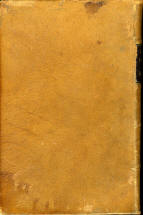 |
Continue to:
Page 9
Medical Book Collection
Pages:
1
|
1a
|
2
|
2a
|
3
|
3a
|
4
|
4a
|
5
|
5a |
6
See information on
Medical education and lecture cards
during and before the Civil War
|
Wanted: Medical
textbooks marked for the U.S.A. Medical or Hospital Dept. please
contact us for a quote before you sell |
|
|